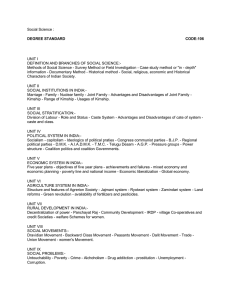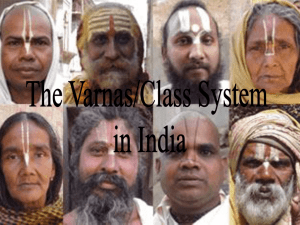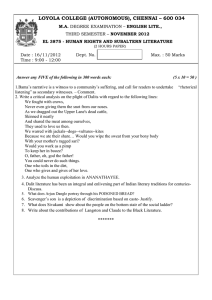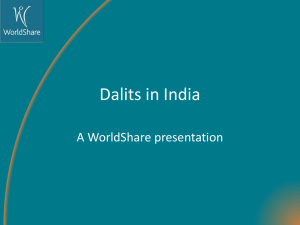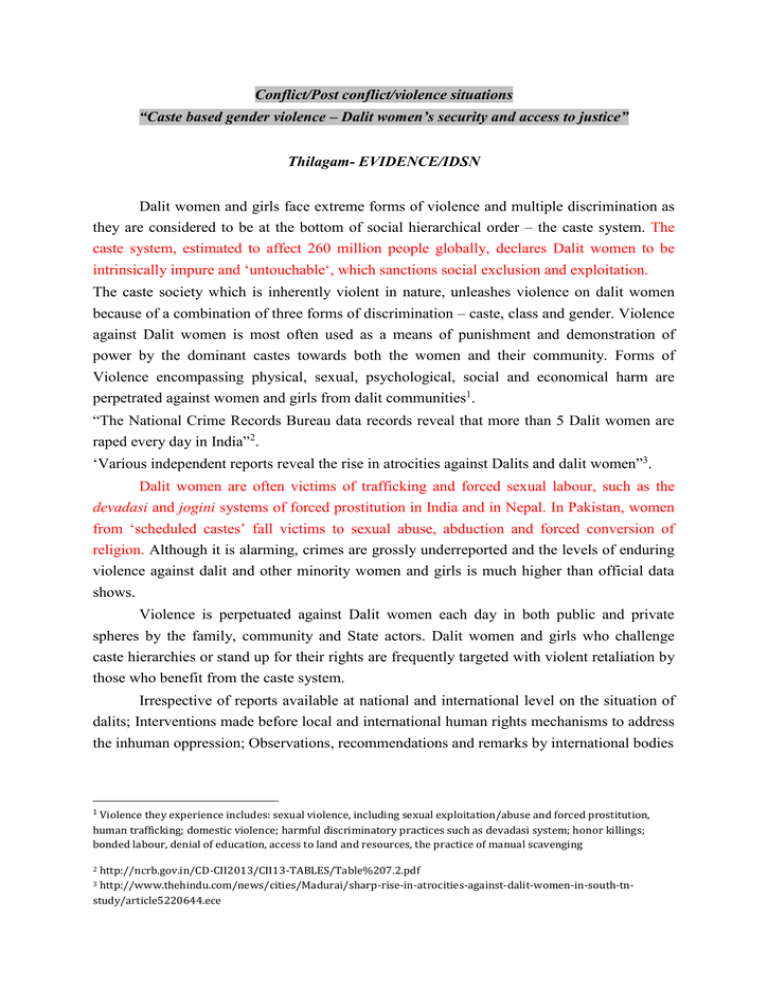
Conflict/Post conflict/violence situations
“Caste based gender violence – Dalit women’s security and access to justice”
Thilagam- EVIDENCE/IDSN
Dalit women and girls face extreme forms of violence and multiple discrimination as
they are considered to be at the bottom of social hierarchical order – the caste system. The
caste system, estimated to affect 260 million people globally, declares Dalit women to be
intrinsically impure and ‘untouchable‘, which sanctions social exclusion and exploitation.
The caste society which is inherently violent in nature, unleashes violence on dalit women
because of a combination of three forms of discrimination – caste, class and gender. Violence
against Dalit women is most often used as a means of punishment and demonstration of
power by the dominant castes towards both the women and their community. Forms of
Violence encompassing physical, sexual, psychological, social and economical harm are
perpetrated against women and girls from dalit communities1.
“The National Crime Records Bureau data records reveal that more than 5 Dalit women are
raped every day in India”2.
‘Various independent reports reveal the rise in atrocities against Dalits and dalit women”3.
Dalit women are often victims of trafficking and forced sexual labour, such as the
devadasi and jogini systems of forced prostitution in India and in Nepal. In Pakistan, women
from ‘scheduled castes’ fall victims to sexual abuse, abduction and forced conversion of
religion. Although it is alarming, crimes are grossly underreported and the levels of enduring
violence against dalit and other minority women and girls is much higher than official data
shows.
Violence is perpetuated against Dalit women each day in both public and private
spheres by the family, community and State actors. Dalit women and girls who challenge
caste hierarchies or stand up for their rights are frequently targeted with violent retaliation by
those who benefit from the caste system.
Irrespective of reports available at national and international level on the situation of
dalits; Interventions made before local and international human rights mechanisms to address
the inhuman oppression; Observations, recommendations and remarks by international bodies
Violence they experience includes: sexual violence, including sexual exploitation/abuse and forced prostitution,
human trafficking; domestic violence; harmful discriminatory practices such as devadasi system; honor killings;
bonded labour, denial of education, access to land and resources, the practice of manual scavenging
1
http://ncrb.gov.in/CD-CII2013/CII13-TABLES/Table%207.2.pdf
http://www.thehindu.com/news/cities/Madurai/sharp-rise-in-atrocities-against-dalit-women-in-south-tnstudy/article5220644.ece
2
3
and human rights institutions including the UN High Commissoner and UN Secretary
General, the governments of caste affected countries continue to be in denial. India denied
caste as a factor of gender inequality in the recently held Asian and Pacific Conference on
Gender Equality and Women's Empowerment: Beijing +204 .
India’s reluctance to acknowledge the reality, to accept its responsibility to uphold the
legal obligations to address the discrimination and cruelty of the caste system, continues. Yes,
our country has guaranteed constitutional safeguards and mechanisms to protect dalit and
other minority women. But still caste discrimination continues to be a social evil experienced
everyday in several covert forms, and in acts of brutal violence. The reality proves that
governments have failed in its due diligence to protect the rights of dalit women and girls; the
laws are not effectively implemented to prevent the atrocities against dalit and minority
women. The Government has failed to challenge the deep-rooted discriminatory attitudes that
underpin the caste system and subordination of women. This failure and the callous apathy of
the system in responding to cases of violence against Dalit women and girls, has indeed
perpetuated impunity. Most women do not report violence and studies shows that only 1% of
the cases that are actually filed end in convictions5. Whereas the conviction rate for rapes
against women in India is around 25%, it is only 2% for women of caste-affected
communities6.
Caste is not an issue confined to India alone, it is a global issue, it is not only an issue of
dalits alone, it is an issue against humanity. Therefore I urge the governments of all caste
affected countries, to break the denial, to recognise the greatest struggle for human dignity, to
show full commitment to eradicate the age old structures that are the root causes for the
discrimination and violence faced by dalit and other minority women.
Finally, as caste-based gender violence is widespread and enduring, systematic, rights-based
and holistic efforts are needed to ensure security and access to justice for dalit and minority
women.
While endorsing the draft recommendations, 1 call upon the forum to include caste-based
discrimination on par with other forms of discrimination in the recommendations and to
explicitly mention and consider caste identities and caste-affected communities in the calls
for particular focuses in approaches, policy and legislation.
I would also call for promotion and support for the endorsement of the UN draft Principles
and Guidelines for the Effective Elimination on Discrimination based on Work and Descent.
4http://www.thehindu.com/news/national/india-denies-caste-as-factor-of-gender
inequality/article6612210.ece
key issue paper on Dalit women: IDSN briefing paper on Dalit Women
http://idsn.org/fileadmin/user_folder/pdf/New_files/Key_Issues/Dalit_Women/DALIT_WOMEN__IDSN_briefing_paper.pdf
5IDSN
6http://timesofindia.indiatimes.com/city/jaipur/Dalit-women-cases-Crime-conviction-rate-
poor/articleshow/9131045.cms?referral=PM
As an Immediate measure to ensure security and justice , Governments should:
a. Ensure enabling environment for minority women to access formal justice - by
identifying and breaking the barriers that minority women face while accessing justice.
b. Ensure Law enforcement agencies and other state mechanisms – bureaucrats, welfare
departments, medical and para medical agencies, local bodies - are sensitized for
effectively addressing the grievances of the minority women and her community. Where
officials fail to undertake their duty to protect and assist minority women without
discrimination, they must be held accountable for their actions
c. Conduct Fact- finding and research to understand the violence and its underlying root
causes and implement policies and programmes to address the root causes
d. Ensure that Dalit and other minority women who report violence are protected from
retaliation and prevent renewed violence against them including social boycotts and
restrictions against dalit women and the community
Preventive measures
a. With an effective implementation and enforcement of laws, the government should
also address attitudes and prejudices that lead to violence and foster the culture of
impunity. They should conduct public campaigns to promote equality and challenge
discrimination for example through schools and the media
b. Initiate processes to challenge discrimination based on caste and gender by
encouraging dialogue and sensitisation of non dalit communities and men.
c. The government should identify caste gender conflict prone areas and provide
additional resources to address underlying issues in these areas.
d. Caste and gender disaggregated data is to be collected, analysed and made publically
available.
I conclude by appreciating the commitment against discrimination and atrocities
against minorities, I call for continuous and enhanced high level advocacy by the
OHCHR and UN agencies for elimination of discrimination and atrocities based on
caste against dalits and dalit women. Thank you!

